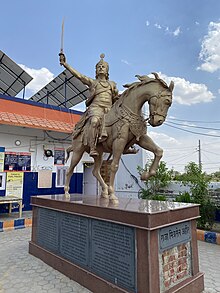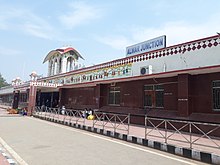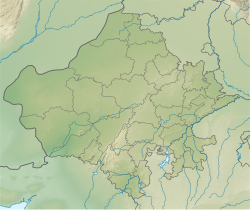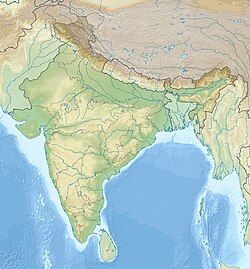Alwar | |
|---|---|
City | |
 Scenic view of Alwar city (RJ) from Bala Qila | |
| Nickname: Scotland of Rajasthan | |
| Coordinates: 27°32′59″N 76°38′08″E / 27.549780°N 76.635539°E | |
| Country | |
| State | Rajasthan |
| District | Alwar |
| Government | |
| • Type | Municipal Corporation |
| • Body | Alwar Municipal Corporation |
| Area | |
| • City | 250 km2 (100 sq mi) |
| Elevation | 268 m (879 ft) |
| Population (2024) | |
| • City | 445,000 |
| • Rank | 8th in Rajasthan |
| • Density | 1,800/km2 (4,600/sq mi) |
| • Metro | 483,000 |
| Demonym | Alwariya |
| Languages | |
| • Official | Hindi |
| • Regional | Ahirwati Rajasthani, Mewati |
| Time zone | UTC+5:30 (IST) |
| PIN | 301001, 301002 |
| ISO 3166 code | RJ-IN |
| Vehicle registration | RJ-02 |
| Website | Alwar Municipal Corporation Alwar District |
Alwar (Rajasthani Pronunciation: [əlʋəɾ]) is a city located in India's National Capital Region and the administrative headquarters of Alwar District in the state of Rajasthan. It is located 150 km south of Delhi and 150 km north of Jaipur.
Etymology
[edit]There are several theories about the derivation of the name Alwar. Alexander Cunningham, the British Indian archeologist, believed that the city derived its name from the Salva tribe and was originally Salwapur, then Salwar, Halawar and eventually Alwar, According to another school it was known as Aravalpur or the city of Aravali.
Some others hold that city is named after Khanzada Alawal Khan Mewati (the Muslim Khanzada prince who wrested Alwar from Nikumbh Rajputs)[citation needed]. A research conducted during the reign of Maharaja Jai Singh of Alwar revealed that Maharaja Alaghraj, second son of Maharaja Kakil of Amber. ruled the area in the eleventh century and his territory extended up to the present city of Alwar. He founded the city of Alpur in 1106 Vikrami Samvat (1049 A.D.) after his own name which eventually became Alwar[citation needed]. It was formerly spelt as Ulwar but in the reign of Jai Singh the spelling was changed to Alwar[citation needed]. Some sources say that the name Alwar comes from the Persian word timber.[1][better source needed]
History
[edit]Ancient history
[edit]The ancient name of Alwar is Salva or Salwa .[2][3]Alwar was a part of the Matsya Kingdom Ruled by Meenas, one of the 16 ancient Mahājanapadas.[4] In late Vedic texts (such as the Jaiminiya Brahmana), the Salva or Salvi tribe is described as a non-Vedic tribe that occupied Kurukshetra and conquered the Kuru Kingdom[5]
The Salvas
[edit]The Salvas settled along the Yamuna river and the Alwar province of Rajasthan after attacking the Kuru kingdom, and they later accepted Vedic culture by the end of the Vedic era as they converged with the remaining Kurus and the Surasena mahajanapada, near Matsya kingdom.[6]
Medieval history
[edit]
Alwar was ruled by multiple dynasties. Notable dynasties included the Jadauns of Braj, Nikumbh Rajputs, the Khanzada Rajputs, the Badgujar Rajputs, and the Naruka Rajputs who took the control over this area. The Maratha Empire also ruled this region for a short period. Rao Raja Pratap Singh Naruka, captured the Alwar Fort from the Jat kingdom of Bharatpur State, and laid down the foundation for modern day Alwar. After the Battle of Mandan, much of the city was annexed by Rao Mitrasen.

Hemchandra Vikramaditya (Hemu), born in Machari, Rajgarh, a village in Alwar, was a Hindu emperor of North India during the 16th century. This was a period when the Mughals and Afghans were vying for power in the region. Hemu captured Delhi on 7 October 1556 after defeating the Mughal forces in the Battle of Delhi in the Tughlaqabad area in Delhi, and became the de facto emperor. He won twenty-two battles in succession and became the last Hindu emperor of Delhi. In 1556, after his defeat in the Second Battle of Panipat, he was executed and Mughal regime was restored in North India.
Colonial era
[edit]
Alwar State, a princely state established in 1770, was established by a Kachwaha Rajput named Pratap Singh Naruka who was earlier a jagirdar of "Dhai Gaon" (two-and-a-half villages) near Machari. His successor, Bakhtawar Singh Naruka, was defeated after launching an armed incursion into neighbouring Jaipur State (ruled by their Kachwaha seniors, erstwhile overlords of his predecessor) and being forced to accept the consequent treaty mediated by East India Company prohibiting him from political relations with other states without the consent of the colonial British.[7] According to the "Gazetteer of Ulwar" published by the British raj, Alwar State was subdivided into four regions:
- Rath region: current Behror and Neemrana, was ruled by Lah Chauhan Rajput zamindar who had descended from Prithviraj Chauhan.[8] Sahesh Mal was a son of Raja Sangat Singh Chauhan. Sangat was the great-grandson of Chahir Deo Chauhan, brother of famous king Prithviraj Chauhan.[9] In accordance with the pledge by the Raja Sangat Singh Chauhan to his younger queen for marrying her in his old age, her two sons from him were bestowed the Rath area and its headquarter of Mandhan near Neemrana.[8] King Sangat Singh Chauhan's 19 sons from the older queen set out to seek their fortunes.[8] Of the 19 brothers, Harsh Dev Chauhan and Sahesh Mal Chauhan arrived in the Gurgaon district.[8] Lah Chauhan, the ruler of Rath, was a son of raja Sangat Singh Chauhan by the younger Rani whose two sons became inheritors of Raja Sangat Singh's territory of Rath with its headquarter at Mandhan when other 19 sons from the other wives were required to quit the kingdom as per the promise of Raja Sangat.[8][10][11][12]

- Wai region: current Bansur and Thana Ghazi, was ruled by Shekhawat rajput zamindars.
- Narukhand region: current Rajgarh and Laxmangarh, was ruled by Naruka clan of Rajputs same as that of the ruling kings of the Alwar State
- Mewat region: current Palwal and Nuh districts, had the highest population of the Meo Muslims.
Post-independence
[edit]Alwar acceded to the dominion of India following the independence of India in 1947. On 18 March 1948, the state merged with three neighbouring princely states (Bharatpur, Dholpur and Karauli) to form the Matsya Union. On 15 May 1949, it was united with neighbouring princely states[which?] and the territory of Ajmer to form the present-day Indian state of Rajasthan. Alwar was designated as part of the National Capital Region, resulting in additional development projects including rapid-rail to Delhi and drinking water improvements.[13] The military cantonment of Itarana lies on the outskirts of Alwar.
Tourist attractions
[edit]Fairy Queen
[edit]The Fairy Queen, a national treasure (cultural artifact) of India and the world's oldest working locomotive engine (c. 1855 CE),[14] operates as a tourist luxury train between Delhi and Alwar. In 1998 it was listed in the Guinness Book of Records as the world's oldest steam locomotive in regular service. The Fairy Queen runs on the same route as the Palace on Wheels, the tourist train launched in 1982, and was awarded the National Tourism Award in 1999.
Bala Qila
[edit]Bala Qila (lit. "High Fort"), also known as Alwar Fort, is a fort approximately 300 meters above the city, founded by the 15th-century Khanzada Rajput ruler Hasan Khan Mewati and built on the foundations of a 10th-century mud fort.[15] Situated on the Aravalli Range, the fort is 5 kilometres long and about 1.5 kilometres wide with turrets, a large gate, a temple, and a residential area.[16]

City Palace
[edit]The City Palace, also known as Vinay Vilas Mahal, built in 1793 CE by Raja Bakhtawar Singh, blends the Rajputana and Islamic architectural styles and has marble pavilions on lotus-shaped bases in its courtyard. The palace houses Government Museum, Alwar with a collection of manuscripts, including one depicting Emperor Babur’s life, Ragamala paintings and miniatures, and historic swords that once belonged to Muhammad Ghori, Emperor Akbar and Aurangzeb; and a golden Durbar hall. This palace that once belonged to the Maharaja (lit. Great Ruler) has now been converted into a District Administrative office also housing the District Court.[17]
Sariska Tiger Reserve
[edit]The Sariska Tiger Reserve, a National Park and Tiger Reserve, is located in the Aravali hills only a few kilometres away from Alwar. Declared a Wildlife reserve in 1955 and a National Park in 1982, it is the first reserve in the world to have successfully relocated tigers. The sanctuary, which became a part of India's Project Tiger in 1978, also preserves other species including rare birds and plants.[18]
Bhangarh Fort
[edit]Bhangarh Fort, branded as the fourth most haunted palace in the world, and the most haunted palace in Asia, is a 17th-century fort built by Bhagwant Das for his younger son Madho Singh I.[disputed (for: Identity of father/son are being discussed elsewhere) – discuss] The fort, a monument protected by the Archaeological Survey of India and is known for its association to legends and paranormal activities,[19] is a tourist attraction for visitors across the world.[20]
Siliserh Lake
[edit]Siliserh Lake is 19th century lake created by Maharaja Vijay Singh of Alwar, situated 8 miles southwest of Alwar.
Hill Fort Kesroli
[edit]Hill Fort Kesroli, a 14th-century fort, has now been converted into and is conserved as a heritage hotel.[21]
Transport
[edit]
As of 2019, the most common modes of medium-distance transport in Alwar are government-owned services such as flights, as well as privately operated lok pariwahan buses, taxis and auto rickshaws. Bus services operate from the Alwar old Bus Station which is 5 km away from the Alwar railway junction. In addition to this it is also planned that a metro rail system from Delhi to Alwar via Behror route will be started. The nearest airports to Alwar are Indira Gandhi International Airport in Delhi (143 km away), Jaipur International Airport (150 km away), and an airport currently under development in Bhiwadi airport (90 km away). Alwar Junction railway station, on the Delhi–Jaipur line, is connected with Delhi, Jaipur, and Mumbai. Alwar is connected by roads from major cities of Rajasthan and nearby states.[22][23][24]
Geography
[edit]Alwar is located at 27°34′N 76°36′E / 27.57°N 76.6°E. It has an average elevation of 271 m (889 ft). The Ruparail River is a major river near the city. Alwar is fairly rich in mineral wealth; it produces marble, granite, feldspar, dolomite, quartz, limestone, soap stone, barites, copper clay, copper ore and pyrophylite.[25]
Climate
[edit]Alwar has a hot semi-arid climate (Köppen climate classification BSh) with long, extremely hot summers and short, mild to warm winters.The climate here is considered to be a local steppe climate. The average maximum temperature in the summers ranges between 41 °C (106 °F) to average minimum of 28 °C (82 °F). The winter temperature falls in the range average high of 21 °C (70 °F) of to average low 8 °C (46 °F). Alwar experiences a short monsoon. The average annual rainfall is about 67 cm which mostly falls in July & August due to monsoon.[26] The highest temperature ever recorded in Alwar is 50.6 °C (123.1 °F) on 10 May 1956 & lowest is −0.8 °C (30.6 °F) recorded on 12 January 1967. It had record of highest temperature ever recorded of India till 2016, when a town Phalodi in Jodhpur district of Rajasthan recorded 51.0 °C (123.8 °F) on 19 May 2016.
| Climate data for Alwar (1991-2020, extremes 1956–present) | |||||||||||||
|---|---|---|---|---|---|---|---|---|---|---|---|---|---|
| Month | Jan | Feb | Mar | Apr | May | Jun | Jul | Aug | Sep | Oct | Nov | Dec | Year |
| Record high °C (°F) | 29.0 (84.2) |
35.0 (95.0) |
39.9 (103.8) |
46.4 (115.5) |
50.6 (123.1) |
47.3 (117.1) |
43.8 (110.8) |
41.2 (106.2) |
40.1 (104.2) |
40.6 (105.1) |
35.6 (96.1) |
29.7 (85.5) |
50.6 (123.1) |
| Mean daily maximum °C (°F) | 20.5 (68.9) |
24.5 (76.1) |
30.8 (87.4) |
37.2 (99.0) |
40.1 (104.2) |
38.4 (101.1) |
33.4 (92.1) |
31.7 (89.1) |
32.6 (90.7) |
32.6 (90.7) |
27.7 (81.9) |
22.5 (72.5) |
31.0 (87.8) |
| Daily mean °C (°F) | 13.9 (57.0) |
17.5 (63.5) |
23.4 (74.1) |
29.7 (85.5) |
33.3 (91.9) |
33.1 (91.6) |
29.6 (85.3) |
28.1 (82.6) |
28.0 (82.4) |
26.0 (78.8) |
20.9 (69.6) |
15.7 (60.3) |
24.9 (76.9) |
| Mean daily minimum °C (°F) | 7.6 (45.7) |
10.7 (51.3) |
15.7 (60.3) |
21.5 (70.7) |
25.9 (78.6) |
27.9 (82.2) |
26.4 (79.5) |
25.2 (77.4) |
23.8 (74.8) |
19.5 (67.1) |
14.5 (58.1) |
9.5 (49.1) |
19.0 (66.2) |
| Record low °C (°F) | −0.8 (30.6) |
2.4 (36.3) |
7.3 (45.1) |
11.2 (52.2) |
15.7 (60.3) |
20.7 (69.3) |
20.6 (69.1) |
20.1 (68.2) |
16.8 (62.2) |
12.0 (53.6) |
6.1 (43.0) |
1.4 (34.5) |
−0.8 (30.6) |
| Average rainfall mm (inches) | 14 (0.6) |
17 (0.7) |
12 (0.5) |
12 (0.5) |
19 (0.7) |
72 (2.8) |
190 (7.5) |
223 (8.8) |
86 (3.4) |
15 (0.6) |
7 (0.3) |
5 (0.2) |
672 (26.6) |
| Average rainy days | 2 | 2 | 2 | 2 | 4 | 8 | 14 | 15 | 8 | 2 | 1 | 1 | 61 |
| Average relative humidity (%) | 61 | 52 | 38 | 24 | 27 | 43 | 69 | 76 | 64 | 46 | 48 | 56 | 50 |
| Mean daily sunshine hours | 8.8 | 9.7 | 10.6 | 11.5 | 12.1 | 11.8 | 9.4 | 8.4 | 9.3 | 10.1 | 9.5 | 9.1 | 10.0 |
| Source 1: India Meteorological Department[27] | |||||||||||||
| Source 2: Climate Data[28] | |||||||||||||
Demographics
[edit]| Year | Pop. | ±% |
|---|---|---|
| 1891 | 52,400 | — |
| 1901 | 56,700 | +8.2% |
| 1911 | 41,300 | −27.2% |
| 1921 | 44,800 | +8.5% |
| 1941 | 54,100 | +20.8% |
| 1951 | 57,900 | +7.0% |
| 1961 | 72,700 | +25.6% |
| 1971 | 100,800 | +38.7% |
| 1981 | 140,000 | +38.9% |
| 1991 | 210,100 | +50.1% |
| 2001 | 266,203 | +26.7% |
| 2011 | 341,422 | +28.3% |
| Source: [29] | ||
At the time of the 2011 census, the population of Alwar city and Alwar district were 341,422 and 3,674,179 respectively, with Hindus representing 90.7% of the population, Muslims representing 4.3%, Sikhs representing 2.6%, Jains representing 2.1%, and the remaining 1.3% belonging to other religions.[30][31]
Education
[edit]Raj Rishi Bhartrihari Matsya University was established in 2012–13 . Alwar has several schools such as Alwar Public School, Shri Oswal Jain Senior Secondary School, St. Anselm's Senior Secondary School, Kendriya Vidyalaya, Adinath Public School, Knowledge City School, Chinar Public School, Lords International School, Sri Guru Harkrishan Public School, Step By Step Senior Secondary School, Raath International School, National Academy and Silver Oak, and colleges (Raj Rishi college, Siddhi Vinayak College, Presidency College, Government Law College, KCRI College, IET College). The Employee's State Insurance Corporation (ESIC) Medical College is constructed with a whooping INR 800 crore budget and started operating from 2017.[32]
Notable people
[edit]- Saurabh Singh Shekhawat
- Sakshi Tanwar
- Jitendra Kumar
- Imran Khan[33][34]
- Aastha Chaudhary
- Bhuvneshwari Kumari
- Mahesh Sharma
- Jitendra Singh
- Alok Bhargava
References
[edit]- ^ Ram, Maya (1964). Rajasthan District Gazetteer Alwar. Jaipur. p. 1.
((cite book)): CS1 maint: location missing publisher (link) - ^ Mallik, Swetabja (15 July 2019). "History and Heritage: Examining Their Interplay in India". International Conference on Archaeology, History and Heritage. The International Institute of Knowledge Management - TIIKM: 01–11. doi:10.17501/26510243.2019.1101.
((cite journal)): Cite journal requires|journal=(help) - ^ Rajasthan (India). Chief Town Planner & Architectural Adviser. (1982). Draft master plan for Alwar, 1981-2001. The Chief Town Planner & Architectural Adviser. p. 8. OCLC 1000383312.
- ^ "History of Alwar, Origin of Alwar, Alwar History In Rajasthan India". Indiasite.com. Archived from the original on 27 June 2012. Retrieved 7 March 2013.
- ^ Witzel, Michael (1997), "Early Sanskritization Origins and Development of the Kuru State", Recht, Staat und Verwaltung im klassischen Indien, Schriften des Historischen Kollegs, München: Oldenbourg, pp. 27–52, doi:10.1524/9783486594355.27, ISBN 978-3-486-56193-7, retrieved 26 September 2020
- ^ Raychaudhuri, Hemchandra, 1892-1957. (1997). Political history of ancient India : from the accession of Parikshit to the extinction of the Gupta dynasty. Oxford University Press. pp. 61, 736. ISBN 0-19-564376-3. OCLC 38008217.
((cite book)): CS1 maint: multiple names: authors list (link) CS1 maint: numeric names: authors list (link) - ^ One or more of the preceding sentences incorporates text from a publication now in the public domain: Chisholm, Hugh, ed. (1911). "Alwar". Encyclopædia Britannica. Vol. 1 (11th ed.). Cambridge University Press. p. 755.
- ^ a b c d e Henry Miers Elliot and John Beames, Memoirs on the History, Folk-lore, and Distribution of the Races, Volume 1.
- ^ Henry Miers Elliot and John Beames, 1869, Memoirs on the history, folk-lore, and distribution of the races of the North Western Provinces of India: being an amplified edition of the original supplemental glossary of Indian terms. Trübner & co. p.64 and 82.
- ^ Henry Miers Elliot, Supplemental Glossary of Terms Used in the North Western Provinces
- ^ Henry Miers Elliot, Supplement to the Glossary of Indian Terms, A.-J
- ^ Panjab Notes and Queries, Volume 1
- ^ "Bharatpur becomes NCR; Delhi Metro to chug into Alwar soon". daily.bhaskar.com. Archived from the original on 29 November 2014. Retrieved 19 November 2014.
- ^ "World's oldest engine gathers fresh steam", The Times of India, 12 February 2017, archived from the original on 5 June 2017
- ^ "Alwar Tourism: Places to Visit in Alwar - Rajasthan Tourism". tourism.rajasthan.gov.in. Archived from the original on 11 December 2017. Retrieved 10 December 2017.
- ^ Iyengar, Abha (4 May 2017). "Delhi to Alwar: Among the ruins". livemint.com/. Archived from the original on 10 December 2017. Retrieved 10 December 2017.
- ^ Safvi, Rana (28 May 2017). "In a state of neglect". The Hindu. ISSN 0971-751X. Archived from the original on 30 April 2018. Retrieved 10 December 2017.
- ^ "Sariska National Park - complete detail - updated". natureconservation.in. Archived from the original on 10 December 2017. Retrieved 10 December 2017.
- ^ Safvi, Rana (12 November 2017). "Bhangarh: the most haunted fort in India". The Hindu. ISSN 0971-751X. Archived from the original on 30 April 2018. Retrieved 10 December 2017.
- ^ "The Times of India: Latest News India, World & Business News, Cricket & Sports, Bollywood". The Times of India. Archived from the original on 18 July 2013. Retrieved 19 November 2014.
- ^ "Ruins revisited". The Hindu. 29 July 2004.
- ^ "Delhi-Alwar rapid rail: Phase 1 corridor to be connected with Delhi Metro, bus stand, railway station!". The Financial Express. 15 April 2019. Retrieved 4 September 2019.
- ^ "All RRTS stations to have platform screen doors". Moneycontrol. 11 August 2019. Retrieved 4 September 2019.
- ^ Shah, Narendra (13 August 2019). "Regional Rail stations to have platform screen doors". Metro Rail News. Retrieved 4 September 2019.
- ^ "Welcome to Alwar, The Gateway of Rajastan > Mineral Resources". Alwar.nic.in. Archived from the original on 19 June 2014. Retrieved 19 November 2014.
- ^ "Alwar Weather & Climate | Temperature & Weather By Month". en.climate-data.org. Retrieved 23 January 2023.
- ^ "Climatological Tables 1991-2020" (PDF). India Meteorological Department. Retrieved 20 December 2022.
- ^ "Alwar Weather & Climate | Temperature & Weather By Month". en.climate-data.org. Retrieved 23 January 2023.
- ^ "Historical Census of India". Populstat.info. Archived from the original on 17 February 2013. Retrieved 19 November 2014.
- ^ "Alwar District Population Census 2011, Rajasthan literacy sex ratio and density". census2011.co.in. Archived from the original on 16 February 2013. Retrieved 6 April 2013.
- ^ "Alwar City Population Census 2011-2021 | Rajasthan". Archived from the original on 4 November 2016. Retrieved 30 July 2016. Alwar City Population Census 2011
- ^ "अलवर को इसी वर्ष मिलेगा मेडिकल कॉलेज, 2017 में होंगे प्रवेश". Patrika.
- ^ "Meet PM Modi's 'Imran Khan', a teacher who donated 52 educational apps to MHRD".
- ^ "Mr. Mohammad Imran Khan Mewati : Jamnalal Bajaj Award 2019 for Application of Science and Technology for Rural Development".
Bibliography
[edit]- Powlett, P. W. (1838). Gazetteer of Ulwur (Alwar). Retrieved 19 November 2014.
External links
[edit]| 21-gun salute | |
|---|---|
| 19-gun salute | |
| 17-gun salute | |
| 15-gun salute | |
| 13-gun salute | |
| 11-gun salute | |
| 9-gun salute | |



